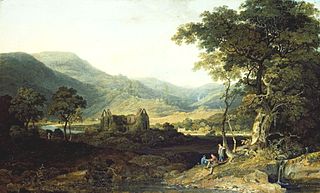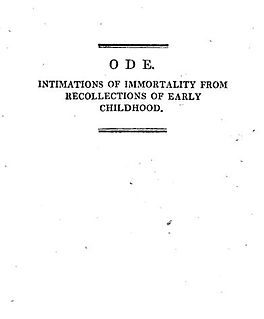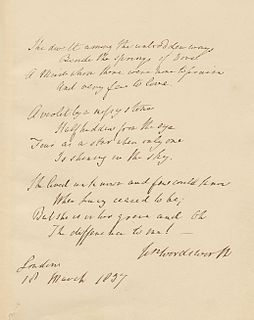Related Research Articles
An ode is a type of lyrical stanza. It is an elaborately structured poem praising or glorifying an event or individual, describing nature intellectually as well as emotionally. A classic ode is structured in three major parts: the strophe, the antistrophe, and the epode. Different forms such as the homostrophic ode and the irregular ode also enter.

Thomas Gray was an English poet, letter-writer, classical scholar, and professor at Pembroke College, Cambridge. He is widely known for his Elegy Written in a Country Churchyard, published in 1751.

William Wordsworth was an English Romantic poet who, with Samuel Taylor Coleridge, helped to launch the Romantic Age in English literature with their joint publication Lyrical Ballads (1798).

"Ode to Psyche" is a poem by John Keats written in spring 1819. The poem is the first of his 1819 odes, which include "Ode on a Grecian Urn" and "Ode to a Nightingale". "Ode to Psyche" is an experiment in the ode genre, and Keats's attempt at an expanded version of the sonnet format that describes a dramatic scene. The poem serves as an important departure from Keats's early poems, which frequently describe an escape into the pleasant realms of one's imagination. Keats uses the imagination to show the narrator's intent to resurrect Psyche and reincarnate himself into Eros (love). Keats attempts this by dedicating an "untrodden region" of his mind to the worship of the neglected goddess.
Pindarics was a term for a class of loose and irregular odes greatly in fashion in England during the close of the 17th and the beginning of the 18th century. Abraham Cowley, who published fifteen Pindarique Odes in 1656, was the poet most identified with the form though many others had composed irregular verses before him. The term is derived from the name of a Greek archaic poet, Pindar, but is based on a misconception since Pindar's odes were in fact very formal, obeying a triadic structure, in which the form of the first stanza (strophe) was repeated in the second stanza (antistrophe), followed by a third stanza (epode) that introduced variations but whose form was repeated by other epodes in subsequent triads. Cowley's Resurrection, which was considered in the 17th century to be a model of the 'pindaric' style, is a formless poem of sixty-four lines, arbitrarily divided, not into triads, but into four stanzas of unequal volume and structure; the lines which form these stanzas are of lengths varying from three feet to seven feet, with rhymes repeated in no order. It was the looseness of these 'pindarics' that appealed to many poets at the close of the 17th century, including John Dryden, Aphra Behn, and Alexander Pope, and many lesser poets, such as John Oldham, Thomas Otway, Thomas Sprat, John Hughes and Thomas Flatman.

Lines Written a Few Miles above Tintern Abbey is a poem by William Wordsworth. The title, Lines Writtena Few Miles above Tintern Abbey, on Revisiting the Banks of the Wye during a Tour, July 13, 1798, is often abbreviated simply to Tintern Abbey, although that building does not appear within the poem. It was written by Wordsworth after a walking tour with his sister in this section of the Welsh Borders. The description of his encounters with the countryside on the banks of the River Wye grows into an outline of his general philosophy. There has been considerable debate about why evidence of the human presence in the landscape has been downplayed and in what way the poem fits within the 18th-century loco-descriptive genre.
Nationality words link to articles with information on the nation's poetry or literature.

"Ode: Intimations of Immortality from Recollections of Early Childhood" is a poem by William Wordsworth, completed in 1804 and published in Poems, in Two Volumes (1807). The poem was completed in two parts, with the first four stanzas written among a series of poems composed in 1802 about childhood. The first part of the poem was completed on 27 March 1802 and a copy was provided to Wordsworth's friend and fellow poet, Samuel Taylor Coleridge, who responded with his own poem, "Dejection: An Ode", in April. The fourth stanza of the ode ends with a question, and Wordsworth was finally able to answer it with seven additional stanzas completed in early 1804. It was first printed as "Ode" in 1807, and it was not until 1815 that it was edited and reworked to the version that is currently known, "Ode: Intimations of Immortality".

"She Dwelt Among the Untrodden Ways" is a three-stanza poem written by the English Romantic poet William Wordsworth in 1798 when he was 28 years old. The verse was first printed in Lyrical Ballads, 1800, a volume of Wordsworth's and Samuel Taylor Coleridge's poems that marked a climacteric in the English Romantic movement. The poem is the best known of Wordsworth's series of five works which comprise his "Lucy" series, and was a favorite amongst early readers. It was composed both as a meditation on his own feelings of loneliness and loss, and as an ode to the beauty and dignity of an idealized woman who lived unnoticed by all others except by the poet himself. The title line implies Lucy lived unknown and remote, both physically and intellectually. The poet's subject's isolated sensitivity expresses a characteristic aspect of Romantic expectations of the human, and especially of the poet's condition.

The Lucy poems are a series of five poems composed by the English Romantic poet William Wordsworth (1770–1850) between 1798 and 1801. All but one were first published during 1800 in the second edition of Lyrical Ballads, a collaboration between Wordsworth and Samuel Taylor Coleridge that was both Wordsworth's first major publication and a milestone in the early English Romantic movement. In the series, Wordsworth sought to write unaffected English verse infused with abstract ideals of beauty, nature, love, longing and death.
"We are Seven" is a poem written by William Wordsworth and published in his Lyrical Ballads. It describes a discussion between an adult poetic speaker and a "little cottage girl" about the number of brothers and sisters who dwell with her. The poem turns on the question of whether to account two dead siblings as part of the family.

On the Morning of Christ's Nativity is a nativity ode written by John Milton in 1629 and published in his Poems of Mr. John Milton (1645). The poem describes Christ's Incarnation and his overthrow of earthly and pagan powers. The poem also connects the Incarnation with Christ's Crucifixion.
"Monody on the Death of Chatterton" was composed by Samuel Taylor Coleridge in 1790 and was rewritten throughout his lifetime. The poem deals with the idea of Thomas Chatterton, a poet who committed suicide, as representing the poetic struggle.
Songs of the Pixies was composed by Samuel Taylor Coleridge during 1793. The poem describes Coleridge's summer vacation and his childhood home. It also incorporates Coleridge's own view of himself as a young poet.
Lines Written at Shurton Bars was composed by Samuel Taylor Coleridge in 1795. The poem incorporates a reflection on Coleridge's engagement and his understanding of marriage. It also compares nature to an ideal understanding of reality and discusses isolation from others.
Frost at Midnight is a poem by Samuel Taylor Coleridge, written in February 1798. Part of the conversation poems, the poem discusses Coleridge's childhood experience in a negative manner and emphasizes the need to be raised in the countryside. The poem expresses hope that Coleridge's son, Hartley, would be able to experience a childhood that his father could not and become a true "child of nature". The view of nature within the poem has a strong Christian element in that Coleridge believed that nature represents a physical presence of God's word and that the poem is steeped in Coleridge's understanding of Neoplatonism. Frost at Midnight has been well received by critics, and is seen as the best of the conversation poems.
"Dejection: An Ode" is a poem written by Samuel Taylor Coleridge in 1802. The poem in its original form was written to Sara Hutchinson, a woman who was not his wife, and discusses his feelings of love for her. The various versions of the poem describe Coleridge's inability to write poetry and living in a state of paralysis, but published editions remove his personal feelings and mention of Hutchinson.
"A slumber did my spirit seal" is a poem written by William Wordsworth in 1798 and published in the 1800 edition of Lyrical Ballads. It is usually included as one of his The Lucy poems, although it is the only poem of the series not to mention her name. The poem is a mere eight lines long; two "stanzas."
Laodamia is a narrative poem by William Wordsworth based on a story from the Trojan War.
Eliza Townsend was a 19th-century American poet who wrote anonymously. She was the first native woman poet whose writings commanded the applause of judicious critics; the first whose poems evinced any real inspiration, or rose from the merely mechanical into the domain of art. Nicholas Biddle said that a prize ode which Townsend wrote for The Port Folio while he was editor of it was in his opinion the finest poem of its kind which at that time had been written in the United States. Many of her other pieces received the best approval of the period, but, as she kept her authorship a secret, it did not enhance her personal reputation. In much of her work, there was a religious and poetical dignity, with all the evidences of a fine and richly-cultivated understanding, which entitled her to be ranked among the distinguished literary women who were her contemporaries. Townsend died in 1854.
References
- This article incorporates text from a publication now in the public domain : James H. Hanford (1920). . In Rines, George Edwin (ed.). Encyclopedia Americana .